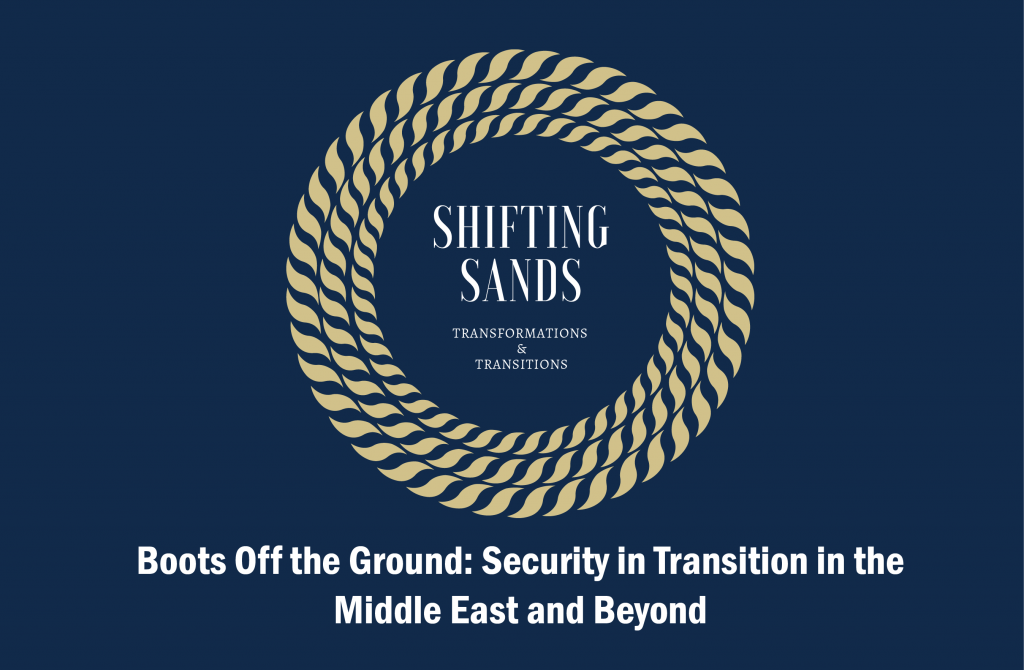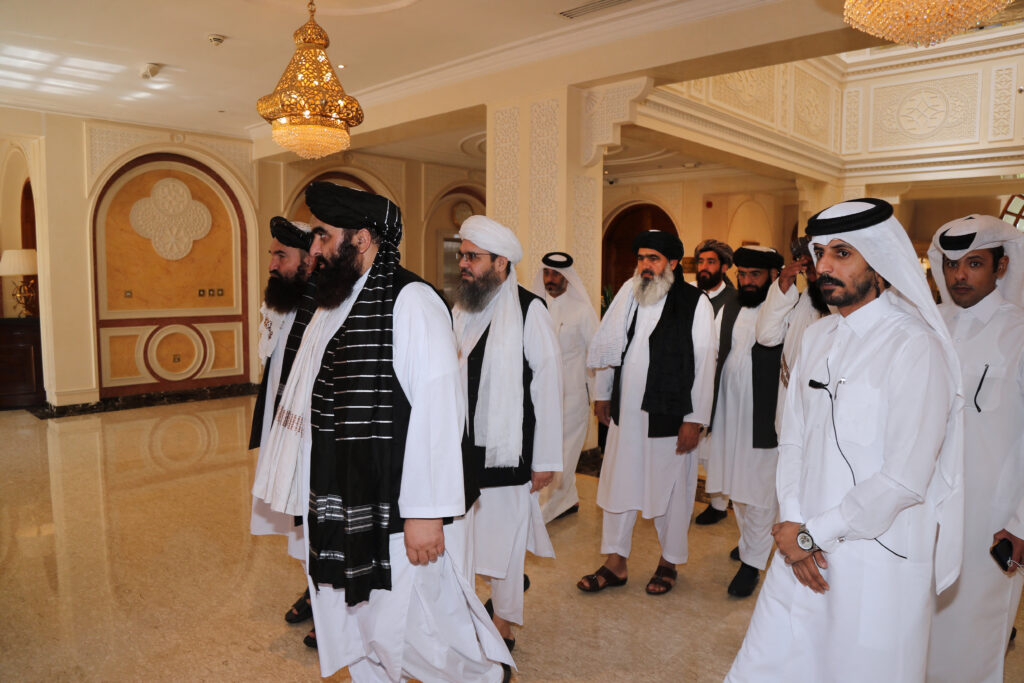
- 18 Sep 2020
[Boots Off the Ground: Security in Transition in the Middle East and Beyond] Episode 6: The Rise of Drones
Abstract
In this new series of monthly podcasts, Dr Alessandro Arduino and Dr Ameem Lutfi invite eminent speakers to share what they see in the future of warfare, as well as the transformation and transition of security architecture in the Middle East, North Africa and Central Asia. Through these podcasts, we will observe how uniformed soldiers, or boots on the ground, are being replaced by private military companies and automated weapons, and will also notice a shift in the theatres of war, from territorial borderlands to shared oceans, air and cyberspace.
In this podcast, we will talk about the role drone usage in contemporary warfare, breaking down the political risks and implications of using drones as opposed to human soldiers.
Listen to the full podcast here:
Full Transcript:
Alessandro (Alex) Arduino: Welcome to the sixth episode of the National University of Singapore’s Middle East Institute’s podcast series “Boots off the Ground: Security in Transition from the Middle East and Beyond”. In this series, we look at the future of warfare, which will see uniformed soldiers, or boots on the ground, being replaced by private military companies, autonomous weapon systems and cyberweapons.
Having discussed private military companies in our previous podcasts, today, we shift our focus to the other important element contributing to the decrease in boots on the ground, namely, the uptake in unmanned combat aerial vehicles, loitering munitions and Istar (intelligence, surveillance, target acquisition and reconnaissance), all commonly referred as drones. My name is Alessandro Arduino and I will be the co-host for the series along with my colleague Ameem Lutfi.
Ameem Lutfi: Thank you, Alex. We are very excited to have with us today, actually not one but two distinguished guests: Dr Aniseh Bassiri Tabrizi and Dr Francesco Milan. Dr Tabrizi and Dr Milan are co-authors of a foundational study on drone proliferation and usage in the Middle East. It is titled Armed, unmanned, and in high demand: the drivers behind combat drones proliferation in the Middle East. In an earlier publication co-authored with Rusi titled Armed Drones in the Middle East: Proliferation and Norms in the Region, Dr Tabrizi looked at it in greater detail.
In lieu of an introduction, Dr Tabrizi is a senior research fellow at the International Security Studies Department of Royal United Service Institute, or Rusi, and Dr Francesco Milan is a lecturer at the Defence Studies Department at King’s College London, based at the Joint Services Command and Staff College, UK Defence Academy. Thank you both for being here with us today.
Alex: Again, thank you for being with us today. As I mentioned in the introduction, until now, most of our guests have talked about the private military sector and I was surprised to see the resonance in the perceived advantages of using private military companies (PMCs) and drones to reduce the political blowback from possible loss of citizen-soldiers’ lives. Do you then think that a country like the United Arab Emirates (UAE), which is wary of losing its citizens, would see a foreign pilot and a drone as competing choices? Having more of one could mean they it reduces its dependence on the other?
Francesco Milan: Thanks for the question. It is especially interesting with a case study like the UAE. I think pretty much like with every other country, the first line of inquiry is the good old blood and treasure question: are intervention wars, perhaps sacrificing officers and soldiers on the front line, and the cost worth it?
One of the things we picked up in our research is the availability of drones, but as you stressed, PMCs mitigate those risks in a couple of ways as well. The case of the UAE is really interesting because you have a very limited pool of combat aircrafts available and you have a very limited pool of pilots, so each one counts in terms of what the UAE has available. So relying on drones mitigates the risks of operating in the air and potentially losing pilots and an aircraft. There’s also a cost element that we need to keep in mind. Developing and maintaining an all-drone fleet is less expensive than having a fully manned fleet, otherwise known as traditional jet fighters with pilots and navigators. In line with that, the cost of losing one of those is way lower than it would be if a country were to lose a jet fighter specifically. So in that sense, like a PMC, drones provide an advantage in terms of mitigating risks and costs.
However, I think there’s a slight difference in the decision-making approach towards using PMCs and drones. One way to put it would be that between the risks and challenges of using drones and the risks and challenges of using private militaries, if we again take the UAE as an example, is to see how its operations in Yemen a few years ago were carried out through land forces and special forces from the Emirates rather than with PMCs. So I can still see scenarios and situations where it’s much more reliable to rely on traditional armed forces rather than PMCs and the same logic applies to drones. Thinking about what drones can achieve and trying to delegate that role to a third party after deciding to use them means giving up some liability and availability of these platforms. So having drones available in-house ready to use means they can be deployed much faster and the use is not calculated by all the contractual limitations that working with a PMC entails.
Ameem Lutfi: Thank you for those points, and if I could just follow up with this, you mentioned that having drones in-house gives you greater control, but it would also make you more responsible for taking ownership of what those drones in your possession do. In your article, there’s one example I found particularly interesting, which was this case of Israel scraping off the manufacturers’ label off of its drones to make it harder to track down where the drones came from. Do you see this as a trend that will continue, where states will continue to use drones as a plausible means of deniability?
Francesco: It’s a really interesting question because one of the things we picked up on in the article is that in short, the answer is yes. There is a trend of exploiting drones for a degree of plausible deniability, but in a way that applies only to scenarios and countries where you might be concerned about the backlash from the international community and where attribution would be a problem. We’ve also seen cases where attribution is part and parcel of the advantage of using drones. One of the key examples of this is Turkey. Turkey has been very proactive in showing and portraying its role internationally, especially through the use of its TAI Anka; it’s sort of the crown jewel in the range of drones it has available. So there are various options when it comes to plausible deniability and whether a country wants to obtain attribution for its actions or not.
As far as those countries that do not want attribution are concerned, this is a platform that gives you a whole range of options if you don’t want to be pointed out as the actor who’s responsible for that action since even if somebody shoots down a drone, they won’t find a pilot in it. Unless, as you said, there are markings or you can ID the specific drone, the manufacturer of the drone, and then the owner of the said drone, it is difficult to pinpoint who is behind that action most of the time. For this reason, I can see this being a growing trend in the use of drones for those actors seeking to operate with plausible deniability.
Alex: Moving on with what you just mentioned, now we can see that it is not not only plausible deniability but also a series of legal imperatives that drones are forcing us to reflect upon like drones as a possible casus belli, or even in the future, we could see PMCs offering pay-per-use combat drones, as drones and PMCs can be imagined as more cost-effective alternatives to conventional warfare. To put numbers to this claim, can you tell us a little bit about the relative difference in the cost of an armed drone and a combat aircraft?
Francesco: Absolutely. Throughout our research, we tried to triangulate some of the information we could find on open source online, but all of this information is not publicly available as some contracts are kept more secretive than others. So going by the information we managed to find through interviews and secondary sources, we tried to combine this with the cost of other platforms to get a sense of what the cost difference in training, maintaining and operating these platforms might be.
One of the examples we found was that the UAE, for example, had a contract for several F-16 jet fighters and each one of them costs around US$200 million. So each platform is roughly US$200 million. We then compared this with the cost of one CAIG Wing Loong that the UAE has been operating on various frontlines and each one of those is around US$2 million. So we’re talking about a 100 fold difference in cost per platform. We’re not comparing apples to apples; there is a slight difference in technology and reliability as well, but it seems because the growing use of drones seems to push the trend in that direction, the downside of giving up a little bit of technological advantage for unmanned capabilities and a much smaller price tag seems to be worth it.
Another example we managed to find in our research would be the cost of an attack helicopter, which armed drones are a viable substitute for. Saudi attack helicopters cost, in this specific contract, US$35 million each and again we can compare that to the price of a much cheaper option, a Chinese drone. But in this case, China provided two armed drones for free to replace a couple of Saudi drones that crashed back in 2017 so you can see how even the market for drones makes a difference in terms of how convenient and inexpensive it is to have access to drones now that China is in the market
Ameem: Since you’re already on the issue of cost, one of the things that you mentioned in your article is that one way states have been trying to reduce their costs is instead of spending their own money on research and development, they shortcut via reverse engineering. You mentioned that there’s some evidence suggesting that Turkey and Iran have already been reverse engineering Israeli drones. Do you see this as a growing trend as well? Are we going to see non-state groups reverse-engineering drones that they have caught and using them for various militias and so on? Related to that, are there any above the ground technology transfer agreements in the Middle East within the drone industry, or can states exchange technology with one other without gaining the reprimand of the international community, and have we already started to see some kind of indigenous industry in these places as well, besides Israel?
Aniseh Bassiri Tabrizi: I think the reverse-engineering issue is something to watch when it comes to non-state actors, but I think it’s something tricky to do. First of all, because you need to get access to the drone, which is not an immediate thing, especially when we are talking about drones, and then when you’re talking about states, it’s also a very peculiar choice to make. You mention cost-effective reasons for choosing to reverse-engineer drones, but in fact, while it may be cost-effective it takes a long time to go down that road.
It also entails some level of isolation internationally, that you cannot rely on other suppliers, which might not only be quicker in delivering the weapon that you’re looking for, but also in providing you with training and direct access to the capability to use that technology. So I think it’s a choice that Iran and Turkey have taken because of their international situation and it’s difficult to envisage other countries making the same choice.
Moving forward, it’s something that needs to be watched when it comes to non-state actors, not necessarily only for armed drones, but also for loitering munitions and other types of lower-level technology. When it comes to your question about agreements, the main agreements that are known at the moment would be the one between Saudi Arabia and China. Saudi Arabia signed an agreement to plan to manufacture its armed drones, getting a license from a Chinese state-owned company, and the idea is to develop its own Wing Loongs. I think the problem is whether it is something that is going to happen, or whether it was just something that was very much in line with Vision 2030, the idea of promoting job employment and to have that kind of prestige technology not supplied by other countries like China. But I think there’s going to be a time lag from the signing of the agreement to the actual transfer of technology.
I think the other point to be made is that even in the case of Iran and Turkey, which reverse-engineered at least one of the types of drones, they still have native core programmes since they have a range of drones, not just the one that was reverse-engineered. They are truly self-sufficient when it comes to changing spare parts and the training and deployment of this technology. So I would say that these are native technologies to the same extent I would say for those of Israel, and while they are different from other countries such as the UAE and Saudi Arabia, which rely on others for supplying this technology, but also for training, for the deployment of the technology, and for whatever spare parts are required.
Alex: Dr Aniseh, on a related note, are most of the drone purchases dealing with just a one time-transfer or do they come with long-term contracts for repair, maintenance and training? I ask this because particularly in the Gulf, one of the reasons that American private arms manufacturers have dominated the market is because they also offer the presence of retired or even serving American soldiers to act as trainers and engineers. The presence of American citizens, in turn, offers the safety-net of the American military in case of an outbreak of war. In your publication, you briefly mentioned the presence of Chinese experts in Iraq as operators and trainers. Is that still true? Do Chinese drones still come with long-term support?
Aniseh: It’s a very good question and it’s a very tricky one. There is very little information on this and I think the reason for that is it’s a very sensitive issue because selling drones is one thing, it is something completely different to maintain that kind of long-term relationship between two countries, which entails a shift from a national perspective in terms of alliance, positioning and all of that. So it’s very, very tricky to find information on that.
However, I think it’s difficult to envisage any kind of procurement of drones without the follow-up training, system maintenance and also presence on the ground to deliver the drones. I think it’s very, very tricky to see that not happening. There is no good information about this, and the Emirates is the main example since they have the most Chinese drones. We know that they are very sensitive about their relationship with China and they don’t talk about what type of relationship it is even if it is very clear that there has been procurement of drones and that that entails a long-term relationship when it comes to the maintenance of these drones.
But I think because of the limited capability of most of these countries to deploy drones, both in-country and outside, they would need to rely on other countries to be able to do so, it would be fair to guess that a co-dependent kind of relationship is taking place.
Ameem: One of the main points in your article is about China breaking the duopoly of the US and Israel on the drone market in the Middle East. You had one caveat in that essay, that you were writing at a time when President Trump was looking to change the restrictions on US exports of drone technology. Did that ever happen and how has the market changed since you published that article?
Aniseh: So the Trump administration has relaxed legislation when it comes to the export of drones from the United States; that happened in 2018 but so far, it has not translated into new sales to countries in the Middle East, in particular, but also broadly speaking, beyond the usual partners. I think the reason for the lack of new sales is twofold. One, it takes a long time to negotiate these deals. Drones are cost-effective compared to conventional technology, but they are still very costly, especially American drones. And two, as I mentioned, American drones are more expensive than drones provided by other countries such as China and that means there is still some negotiation going on behind the scenes for taking over the market that China has dominated for the last few years in the Middle East.
However, it’s fair again to guess that the trend from the Trump administration, especially if we are going to see a second term, is going to be trying to fill the gap of this technology in the Middle East because this fits very much into the US–China competition as the US not only feels threatened commercially, but it is also important in reviving partnerships with countries it has had previously as allies.
Alex: Another question that always comes to mind when discussing drone efficiency is in hybrid conflicts with non-clear territorial frontlines and enemies operating in densely populated areas, how does the collateral damage or loss of innocent lives compare to a conventional on the ground operation?
Francesco: That is one of the problematic areas with armed drones proliferation as much as it is with other types of combat platforms. As you pointed out, as the conflict moves closer and closer to civilians, it becomes much riskier for civilians themselves but also for those who are calling the shots and conducting operations and launching campaigns. The access to drones is a double-edged sword, it provides a degree of safety for those who are operating them but also we’ve seen examples of basically turning airstrikes into a free for all, because again, from the decision-makers perspective, it can be low cost, low risk and high reward to do that. So they do.
In that way, armed drones do inject an element of potential increased risk for civilians. I would say this is in line with broader trends in the way conflict is evolving. The duty to care and the degree to which a country which operates the drones wants to abide by international humanitarian law and the rules of engagement makes a difference. I wouldn’t say that the armed drones existing themselves create the problem, it’s more of a problem in terms of understanding to what extent these platforms enable countries to operate in areas where they wouldn’t be able to operate normally, and the extent to which they want to play by the rules as they do so.
Ameem: Since you’ve already brought up the issue of how drones, to some extent, expand the possibilities of where countries can operate, I was wondering if you could say a little bit more about if drone technology has fundamentally changed the likelihood of war itself or if the limits and possibilities a country imagines of its military operations have expanded, and whether countries are more likely to go to war with drones.
There are few sides to this. One side we saw in Saudi Arabia’s response or reluctance to respond to the attacks on the Aramco field was because of the anonymity provided by drones it is harder to find a reason to counter-attack. I am wondering, how would you balance that. Is it going to lead towards more countries being more reluctant and there being more low-scale dispersed warfare, or is there more likelihood of aggressive warfare as a result of drones?
Aniseh: I think a little bit of both. I think the countries that have been using drones have been using them in conflicts where they probably would have intervened anyway because it is part of their security priorities in specific countries, but also specific conflicts. I’m thinking mainly about Iran, Turkey and the Emirates and their use of drones in specific conflicts that we are familiar with, and I would have to say they would have still intervened even without the presence of drones, but they would have had fewer tools by which to intervene. In terms of propensity of intervention, I think it changes slightly, but it’s not dramatically different. In terms of triggering a conflict between two states, I think that is very much in line with what you see in terms of a reduced threshold for conflict because of the use of drones.
You mention the example of Saudi Arabia; I think that example is a little more complicated because it is true that in the end, despite all the alleged evidence provided by the United States and Saudi Arabia, it is not clear where the drones were flown from and it is difficult to ascertain where exactly the drones came from even if they came from the direction of Iran, and it is even more difficult to retaliate to that type of attack. In this case, I do think part of the reason retaliation did not happen is that Saudi Arabia was relying too heavily on the United States to respond to the attacks, so this example is a bit more complicated.
If you think about the examples of confrontations and tensions between Iran and Israel, for instance, on the Syrian border, it falls in line with the reduced threshold for conflict. It was clear that Iranian drones violated Israeli airspace, but that itself did not trigger a war, but tensions between the two countries remained high through the use of drones. For countries that want to avoid all-out confrontations, so countries like Iran, drones provide the perfect opportunity to do so.
Alex: Now Aniseh and Francesco, please allow me to shift our focus from the Middle East to East Asia. Here in Singapore, there is increasing concern over the deployment of reengineered civilian drones for criminal use or even terrorist attacks. IS’s use of Chinese DJI commercial drones made the news a few years ago. Just a few weeks ago, two Singaporean citizens had to defend themselves in court for operating commercial drones over Singaporean military facilities. We even had a case of drones used as a drug mule from Malaysia to Singapore. In your opinion, how easy or difficult is it for a non-state group to re-control a captured drone? Or even to retrofit a non-armed drone to carry a dangerous payload?
Francesco: First, with regards to the more criminal usage of drones, it is very easy to find something commercially available and use it for logistical purposes to move drugs or whatever an illicit organisation is trying to move from point A to point B. When it comes to arming drones, things become slightly more complicated, but it is not entirely impossible to achieve. In a way, retrofitting a potentially captured drone is fairly difficult and complex to achieve. Let’s say a non-state actor gets its hands on a drone that has crashed or was shot down. Using that as a blueprint to develop your drone or to get control of that drone itself will be difficult because of the technology within it, and the encryption of various components within it. It is much more likely that some smaller components might be taken and used on an existing platform, but taking control of that drone specifically is quite a difficult task.
That being said, violent non-state actors having access to makeshift combat drones is a different story because we’ve seen over the past 10 years the extent to which groups such as IS and other groups around the Middle East have been able to develop their drones. This is similar to the evolution in IEDs (improvised explosive devices) we’ve seen since 2001 with Afghanistan first and then Iraq. The learning curve is a bit steep but also as groups test new ways and means to use drones, they come up with better and more technologically advanced ideas as they progress.
Taking the conflict in Syria as an example, there have been a variety of makeshift armed drones ranging from the simplest US$50 commercially available ‘toy drone’ equipped with a hand grenade and remote switch, to much more sophisticated IS-operated drones with their own navigation systems and payloads. So there is definitely a fast expanding drone market for violent non-state actors. Following its evolution and technological development thus presents an interesting research question.
Ameem: Thank you, and to end the interview, I want to ask you a question that we plan on asking all of our guests: what will the future of warfare and security management in a complex environment look like in the coming 30 years?
Aniseh: When I think about it, I think of complexity, more specifically in terms of the number of actors that might be present in the conflict, both state and non-state actors, more complex dividing lines, more reliability on proxy elements and therefore more challenging in terms of defining alliances and dividing aspects within a conflict. It is going to become trickier to see who is operating from where, whose side someone is on, and whether they are operating through state or non-state actors, whether there is a mix of various elements, and how that would impact the resolution of conflicts.
Francesco: I agree with Aniseh, complexity will be the name of the game. Looking forward, one important thing to understand is that we won’t have one type of conflict. We have been coming out of the so-called counter-insurgency era thinking that counterinsurgency would be what state actors would be doing for the foreseeable future. That is not wrong, but the reality on the ground seems to be that we will be doing a range of things. At the same time, it’s hard to pinpoint one type of conflict that will be present for the next 20 years while other types will be absent. I see the real complexity being that any given state actor who’s trying to navigate security nowadays needs to take into account that they will be doing a whole range of tasks at the same time in different places in the world, sometimes unilaterally sometimes in coalitions, sometimes this will be conventional state vs state, sometimes it could be hybrid or counterinsurgency and all of these are going to happen at the same time. So the range of capabilities countries need to have are larger and the spectrum of options for conflict is broader than it used to be.
Alex: Thank you for your intriguing take on the future of warfare and security management in the next 30 years. I would like to get you to talk a little bit more about drones. What is your take on what platforms drones, specifically combat drones, loitering munitions and Istar, are going to be taken to in the next 30 years to come?
Francesco: As far as flying drones, or unmanned aerial vehicles go, miniaturisation is the way ahead. Swarms are another thing drone developers are looking to achieve as soon as possible, both for combat purposes but also for Istar purposes. As technology advances and makes these improvements possible, it is highly likely the drone field is going to grow exponentially in the future.
Moving from the air to the ground, we are likely to see a growing niche and market for unmanned drone vehicles, so something that may serve as a substitute for boots on the ground effectively. Rather than just operating from the air, these drones would have the capability to control territory on the ground in combination with support from the air. Looking forward as technology develops, the ground component, or ground version of unmanned drones, will become more important and more central as it moves people out of the frontline and recreates advantages you can achieve from the sky on the ground, which is even more critical in certain scenarios.
Aniseh: Echoing what Francesco talked about, it seems like the continuing trend will be proliferation of these technologies across state and nonstate actors. The Missile Technology Control Regime (MTCR) legislation has failed to cap the proliferation of these technologies, and concurrently, over the past few years, countries have begun to see drones as not only useful but also necessary. Couple that with the trend we have been seeing of countries and conflicts deploying these types of technology, it all points to a growing trend of the proliferation of these types of technology.
Ameem: Aniseh and Francesco, thank you very much for joining us today; it has been great listening to your insight. Please allow me to thank our BOTG group at MEI without whom this podcast could never be possible, namely Eugene Lim, Lim Wei Chean, from the Events and Communications Team and MEI Associate Director Carl Skadian. Also special thanks to all our listeners. Please follow us on the various social media platforms and send us your comments and feedback. We would love to hear from you. That’s all for today. Thank you.
Aniseh and Francesco: Thank you very much.
Alex: Thank you.
This transcript was prepared by Sukriti Kalra, Intern, Middle East Institute, National University of Singapore.
About the Speakers

Lecturer
Defence Studies Department, King’s College London &
Dr Aniseh Bassiri Tabrizi
Senior Research Fellow
International Security Studies department
Royal United Services Institute (Rusi)
Presented by Dr Alessandro Arduino & Dr Ameem Lutfi
Middle East Institute, NUS
Dr Francesco F Milan is a lecturer at the Defence Studies Department, King’s College London, based at the Joint Services Command and Staff College, UK Defence Academy. He is also an associate fellow in Conflict, Security, and Development at the International Institute for Strategic Studies (IISS).
His research focuses on violent nonstate actors and civil-military relations. Between 2012 and 2014, he worked on defence procurement with IISS’s Defence and Military Analysis team.

Dr Aniseh Bassiri Tabrizi is a senior research fellow at the International Security Studies department of the Royal United Services Institute (Rusi). Her research is concerned with security in the Middle East, with a particular focus on Iran and Iraq. She is the coauthor of ‘Armed Drones in the Middle East: Proliferation and Norms in the Region’, a report published by Rusi in 2018.




